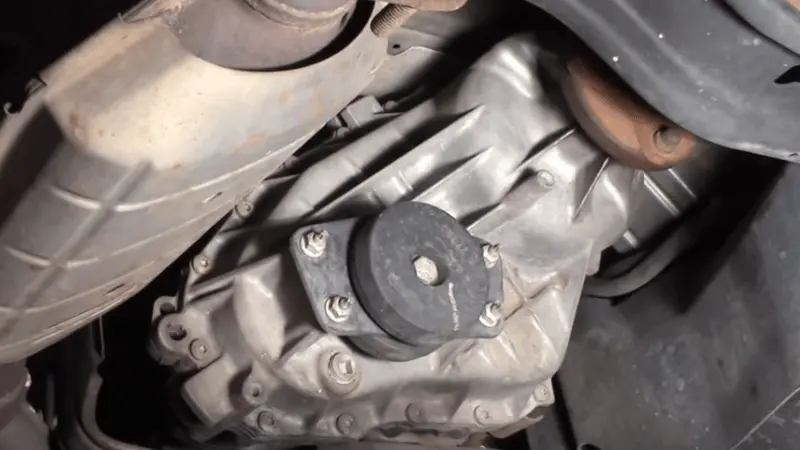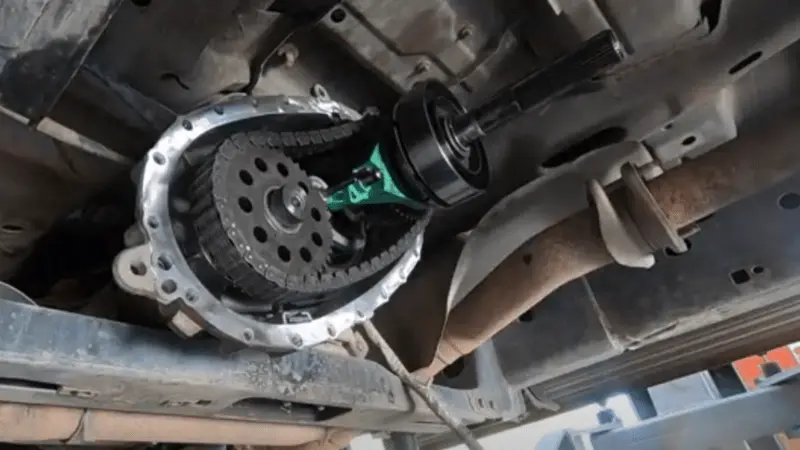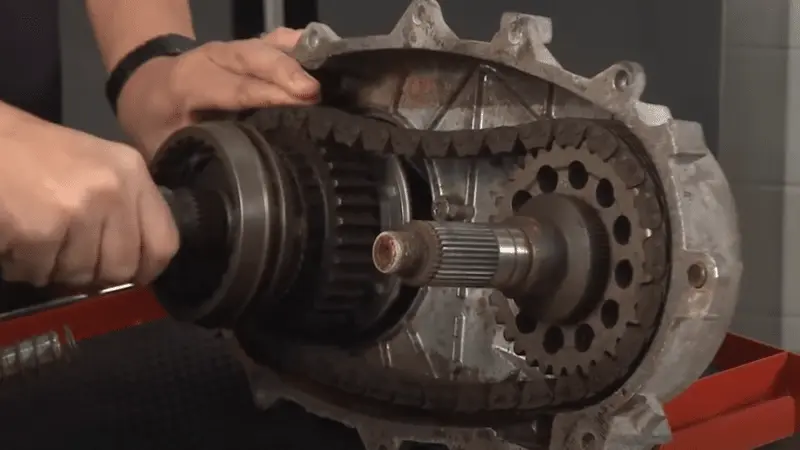When it comes to the health of your vehicle, listening can be just as crucial as looking under the hood. An often-overlooked component that plays a vital role in your vehicle’s performance is the transfer case. But what does a bad transfer case sound like?
What does a bad transfer case sound like? Unusual noises like whining, grinding, and clunking are common auditory cues that indicate potential problems with your vehicle’s transfer case.
In our blog post, we’re diving deep into the auditory cues that signal potential issues.
What Does A Bad Transfer Case Sound Like?

A bad transfer case in a vehicle can emit distinct sounds that signal potential mechanical problems. These noises include whining, snarling, and humming. The transfer case noise often results from worn gears or fluid leaks.
When you hear these sounds, it typically means that the transfer case is experiencing difficulties, and the drop in fluid pressure can make shifting gears more challenging, indicating the need for inspection and potential repairs to address the underlying problems before they worsen.
Symptoms Of A Bad Transfer Case

A transfer case is a crucial component in 4-wheel and all-wheel drive vehicles, responsible for distributing power between the front and rear axles. When a transfer case malfunctions, it can exhibit several symptoms that indicate potential issues. Here are some common symptoms of a bad transfer case:
- Strange Noises: Unusual noises are often the earliest and most apparent signs of transfer case problems. Whining, grinding, or clunking sounds when the vehicle is in motion or shifting between 2-wheel and 4-wheel drive can indicate a malfunctioning transfer case. These noises may indicate worn gears, damaged bearings, or other internal issues.
- Difficulty Shifting Gears: A bad transfer case can make it challenging to shift between 2-wheel and 4-wheel drive modes. You may experience resistance or difficulty engaging or disengaging the transfer case, leading to drivability issues and a reduced ability to adapt to changing road conditions.
- Gear Slippage: When the transfer case is not functioning correctly, you may notice gear slippage, particularly when under heavy acceleration or load. This can result in a loss of power to the wheels, reducing your vehicle’s ability to traverse challenging terrains or pull heavy loads.
- Fluid Leaks: Leaking fluid under your vehicle is a potential sign of a transfer case problem. The transfer case contains lubricating fluid to keep its internal components running smoothly. A leak can occur due to a damaged seal, gasket, or housing, leading to inadequate lubrication and potential internal damage.
- Illuminated Warning Lights: Many modern vehicles have sensors and warning lights to alert you to potential issues. If your vehicle’s computer detects a problem with the transfer case, it may trigger a warning light on the dashboard. Don’t ignore these warnings, as they can help you address the issue before it becomes more severe.
- Vibrations: A failing transfer case can cause vibrations in the vehicle, especially when you’re driving at higher speeds or when it’s engaged in 4-wheel drive. These vibrations may be felt in the floorboard, steering wheel, or entire vehicle.
- Inability to Engage 4-Wheel Drive: If you cannot engage 4-wheel drive when needed, it could be a sign of a transfer case problem. This can be particularly concerning if you frequently drive off-road or in adverse weather conditions where the 4-wheel drive is essential.
- Burning Smell: Overheating or excessive friction within the transfer case can lead to a burning odor. If you notice a burning smell while driving, it’s essential to have your vehicle inspected promptly to avoid more significant damage.
- Loss of Power: A failing transfer case can result in a loss of power to the wheels, especially during acceleration or when climbing steep grades. This can reduce the vehicle’s performance and safety.
- Visual Damage: Inspect the transfer case visually for any signs of physical damage, such as cracks, dents, or bent components. Physical damage can lead to internal issues and may require replacement.
RELATED: How Long Can You Drive With A Bad Transfer Case
How to Fix a Bad Transfer Case?

Fixing a bad transfer case involves a combination of diagnostic work, repairs, or, in some cases, replacement. Here’s a general guide on how to address transfer case issues:
Diagnosis:
Start by diagnosing the problem. Listen for unusual noises, look for fluid leaks, and observe any warning lights on the dashboard. Understanding the specific issue is crucial for effective repairs.
Consult a Professional:
Transfer case issues can be complex, and it’s often best to consult a qualified mechanic or technician. They can perform a thorough inspection using diagnostic tools and determine the extent of the problem.
Replace Fluid and Seals:
If the issue is minor, such as fluid leaks or damaged seals, the transfer case may only require a fluid change or seal replacement. This is relatively straightforward and can help address minor problems.
Repair or Replace Gears and Bearings:
If worn gears or bearings are the culprits behind strange noises or gear slippage, they can be repaired or replaced. Your mechanic will disassemble the transfer case, assess the damaged components, and make necessary repairs.
Solenoid or Sensor Replacement:
If electronic components, such as solenoids or sensors, are causing shifting problems, replacing these components can resolve the issue. This is a common fix for modern transfer cases with electronic controls.
Seal Housing or Case Replacement:
In severe damage to the transfer case housing or internal components, a complete housing or case replacement may be necessary. This is a more extensive repair but can be essential for severe damage.
Transfer Case Overhaul or Rebuild:
For extensive damage or when multiple components are compromised, a complete overhaul or rebuild may be the best solution. This involves disassembling the transfer case, replacing worn parts, and reassembling it to like-new condition.
Full Replacement:
In some cases, when the transfer case is beyond repair or if repair costs are prohibitively high, it may be more cost-effective to replace the entire transfer case. A rebuilt or remanufactured unit is a common choice.
Reinstallation and Testing:
After any repairs or replacements, the transfer case is reinstalled in the vehicle. It’s essential to conduct thorough testing to ensure it operates correctly and produces no unusual noises or issues.
Regular Maintenance:
To prevent future transfer case problems, perform regular maintenance. This includes checking fluid levels, replacing fluid as the manufacturer recommends, and inspecting seals and components for wear and damage.
RELATED: What Happens If Transfer Case Is Low On Fluid
Follow Manufacturer Recommendations:
Always adhere to your vehicle’s manufacturer recommendations and specifications for the type of fluid, maintenance schedule, and other relevant guidelines to maintain the transfer case’s optimal performance.
FAQs
1. What Are Common Sounds Associated With A Bad Transfer Case?
Common sounds of a bad transfer case include whining, grinding, and clunking noises, especially during acceleration or gear shifts.
2. Can Transfer Case Issues Cause Vibrations In The Vehicle?
Yes, a malfunctioning transfer case can result in vibrations felt in the floorboard or steering wheel, often noticeable at higher speeds.
3. Do Warning Lights Always accompany Transfer Case Problems?
No, not always. While warning lights may indicate issues, unusual sounds are often an early sign of transfer case problems.
4. Can A Bad Transfer Case Lead To A Burning Odor In The Vehicle?
Yes, overheating or excessive friction within the transfer case can produce a burning smell, signaling potential problems.
5. Can I Continue Driving With Transfer Case Sounds?
It’s not advisable. Continuing to drive with transfer case noises can lead to more significant damage and costly repairs. It’s best to have the issue inspected and addressed promptly.
Final Words
In vehicle maintenance, listening is just as essential as looking and recognizing the sounds of a bad transfer case. It can save you from costly repairs and ensure your safety on the road.
So, the next time your car emits strange noises like whining, grinding, or clunking, pay close attention and seek professional help. This knowledge empowers you to keep your vehicle in top condition and guarantees a smoother, safer ride. Drive confidently, equipped with an understanding of your vehicle’s unique soundscape.

Eric L. Friedman is a car expert who has worked on Chevy and GMC trucks for over 10 years. He started AutoYolo to help people fix their own cars. On the blog, he shares easy tips, step-by-step guides, and repair advice to make car problems less stressful and more affordable.

